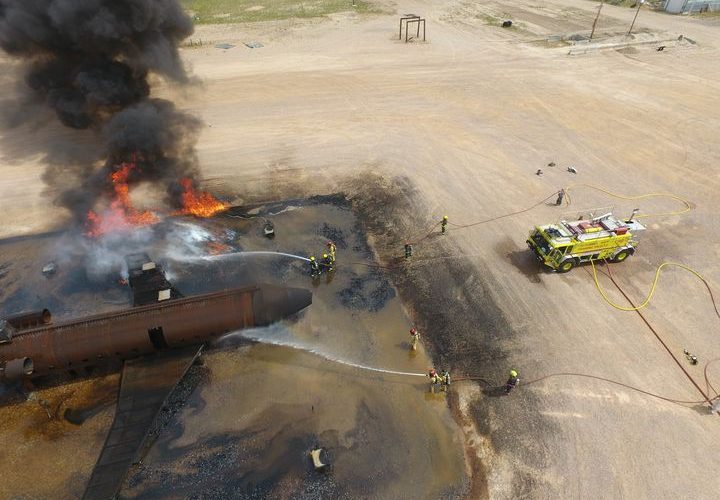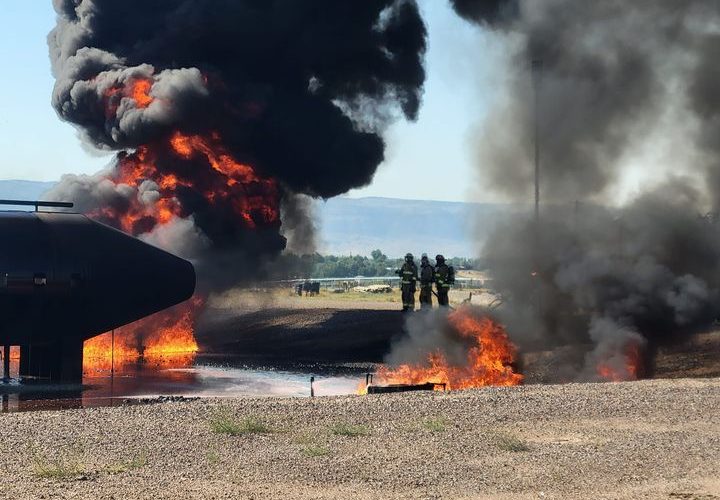Background Information and Challenges
The Aircraft Rescue and Fire Fighting (ARFF) facility and its vehicles were reaching the end of their useful life, making it more difficult for ARFF crews throughout Wyoming and neighboring states to fulfill their annual recertification requirements. More than 2,700 firefighters from approximately 75 departments have trained at the facility since it opened in 1995.
$6.95 million of the $7.4 million total project funds were from an FAA grant, the rest from a state grant and airport funds. Due to this, the FAA’s Buy America Clause applied to the project. Layfield had to provide proof and certification that materials met the clause restrictions, as well as multiple virtual installation reviews and warranty certifications. Kirilia Fire oversaw the construction of the live ignition system and burn staging area in conjunction with the project team.
Initially, GH Phipps ordered 70,000sf of Heatgard® (High-Temperature Geomembrane) 80mil per the construction documents. However, during installation, they discovered they would require an additional 11,700sf of material at the waste collection tank wall area, which Layfield could provide from material in stock.
Due to Wyoming weather, the project season was limited from May-September due to snow and ice conditions. During the final installation review of the project, the first week of September saw the beginning of snowfall.
Solution
GH Phipps approached Layfield with engineer Jviation’s specification and design for an impermeable liner system in the new burn area. They were seeking a diesel and fire-retardant-resistant liner that could withstand the high temperatures of a live burn area and the cold of Wyoming winters, which can go as low as -41F. Layfield’s Heatgard® (High-Temperature Geomembrane) exceeded the specification, and an 80 mil product was approved to begin installation in May 2021.
While most other training centers use propane to simulate fires, ARFF’s system uses diesel fuel to create more realistic fire-fighting conditions. A new 140-by-175-foot burn area (24,500sf) and larger mockup plane replaced the burn area, which had become too costly to maintain.
Using diesel fuel required the airport to take extra environmental precautions. The new burn area has two layers of propriety specialty high-density polyethylene (HDPE) liner and HeatGard® (High-Temperature Geomembrane) to prevent diesel fuel from seeping into the ground and potentially contaminating groundwater. In addition, layers of sand were laid under the piping that carries the diesel, and a layer of rock was installed on top. Geonet was included between the two layers of HDPE to allow for drainage, and a layer of nonwoven geotextile below the liner to allow for separation and protection.
Upgraded software and hardware were added to the control tower training facility to allow for the remote detonation of multiple fires. A larger dedicated classroom, reception area, and restrooms were added to the main facility. A new training vehicle and equipment were acquired.
Results
The enhancements to the ARFF training help emergency personnel from across the region practice skills and earn/maintain FAA-required certifications. The expanded 140’x175’ burn area with a larger mockup plane allowed the facility to move from an Index A to an Index C facility (aircraft 126’-158’ long). Other fire rescue organizations outside the region have contacted the facility to train, as this is the only facility in the United States still offering diesel burn training. The quality and experience of the training for emergency personnel have improved tremendously by offering realistic emergency conditions.

